Which of the following is TRUE of species interactions?
A) They can act as agents of natural selection.
B) The outcome of any species interactions is static through time.
C) They do little to affect species distributions.
D) They cannot affect species abundance.
A) They can act as agents of natural selection.
Epiphytic orchids grow harmlessly on their host trees, and derive their resources from the air and from rain, rather than from their host plant. Which of the following is the best description of this species interaction?
A) herbivory
B) competition
C) parasitism
D) commensalism
D) commensalism
Some birds follow moving swarms of army ants in the tropics. As the ants march along the forest floor hunting insects and small vertebrates, birds follow and pick off any insects or small vertebrates that fly or jump out of the way of the ants. This situation is an example of what kind of species interaction between the birds and the ants?
A) cooperation
B) consumption
C) commensalism
D) parasitism
E) mutualism
C) commensalism
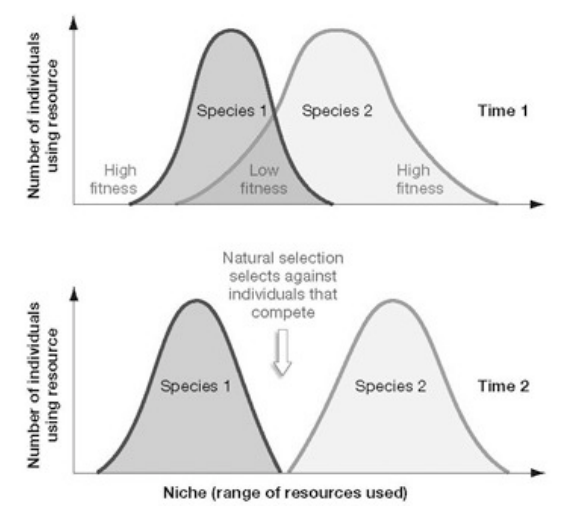
What is the term used to describe the process shown in the panels in the accompanying figure, assuming Time 2 follows Time 1?
A) competition
B) species interaction
C) niche differentiation
D) niche realization
C) niche differentiation
4) Some birds follow moving swarms of army ants in the tropics. As the ants march along the forest floor hunting insects and small vertebrates, birds follow and pick off any insects or small vertebrates that fly or jump out of the way of the ants. What is the result of the association
A) Birds benefit from the association but have no impact on the ants.
B) Birds benefit from the association and harm the ants.
C) Birds and ants benefit from the association.
D) Birds do not benefit from the association, but the ants do.
E) Neither birds nor ants benefit from the association
A) Birds benefit from the association but have no impact on the ants.
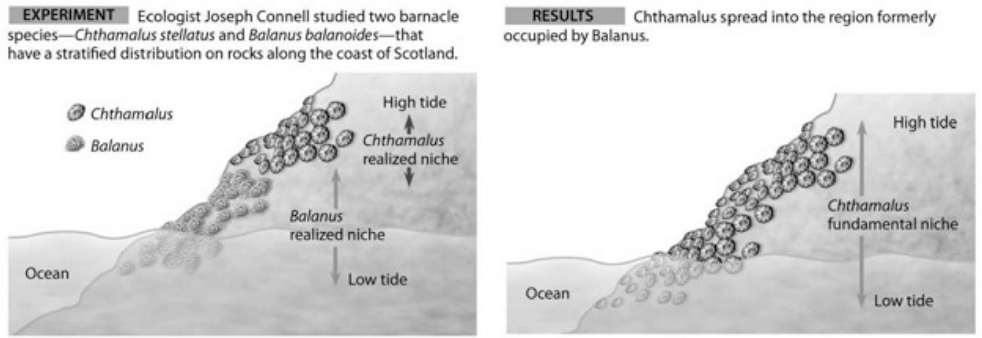
6) Which of the following statements is a valid conclusion of this experiment?
A) Balanus can survive only in the lower intertidal zone because it is unable to resist desiccation.
B) Balanus is inferior to Chthamalus in competing for space on rocks lower in the intertidal zone.
C) The two species of barnacles do not compete with each other because they feed at different times of day.
D) The removal of Balanus shows that the realized niche of Chthamalus is smaller than its fundamental niche.
E) If Chthamalus were removed, Balanus's fundamental niche would become larger.
D) The removal of Balanus shows that the realized niche of Chthamalus is smaller than its fundamental niche.
Connell conducted this experiment to learn more about ________.
A) character displacement in the color of barnacles
B) habitat preference in two different species of barnacles
C) desiccation resistance and barnacle species D) how sea-level changes affect barnacle distribution
E) competitive exclusion and distribution of barnacle species
E) competitive exclusion and distribution of barnacle species
Which is the best way to test the hypothesis that C. is competitively excluded from the lower intertidal zone by B. balanoides?
A) Place individuals of each species in a jar and see which species survives.
B) Remove all B. balanoides from the lower intertidal zone.
C) Transplant B. balanoides to the upper intertidal zone.
D) Clear rocks in an entire area and document recolonization events.
E) Remove all C. stellatus from the upper tidal zone.
B) Remove all B. balanoides from the lower intertidal zone.
In the hypothesis that C. stellatus (a species of barnacle) is competitively excluded from the lower intertidal zone by B. balanoides (another species of barnacle), what could be concluded about the two species?
A) The fundamental and realized niches of B. balanoides and C. stellatus are identical.
B) The fundamental and realized niches of B. balanoides and C. stellatus are different.
C) The fundamental and realized niches of B. balanoides are different, but the fundamental and realized niches of C. stellatus are identical.
D) The fundamental and realized niches of B. balanoides are identical, but the fundamental and realized niches of C. stellatus are different.
D) The fundamental and realized niches of B. balanoides are identical, but the fundamental and realized niches of C. stellatus are different.
Which of the following statements is consistent with the principle of competitive exclusion?
A) Bird species generally do not compete for nesting sites.
B) The random distribution of one competing species will have a positive impact on the population growth of the other competing species.
C) Two species with the same fundamental niche will exclude other competing species.
D) Even a slight reproductive advantage will eventually lead to the elimination of the less well adapted of two competing species.
E) Natural selection tends to increase competition between related species.
D) Even a slight reproductive advantage will eventually lead to the elimination of the less well adapted of two competing species.
The competitive exclusion principle states that ________.
A) it is not possible for two species with the same niche to coexist in the same region
B) it is not possible for two species to compete for the same resources
C) two species with different niches will not compete for the same resources
D) two species with the same niche will constantly be competing for resources
A) it is not possible for two species with the same niche to coexist in the same region
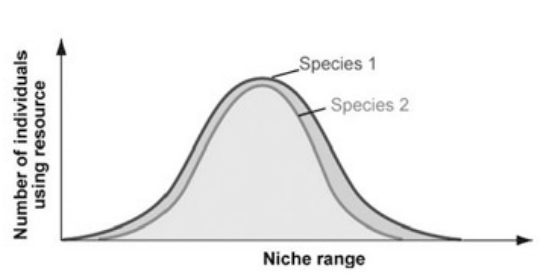
In the accompanying figure, which species is the stronger competitor?
A) species 1
B) species 2
C) Both species compete equally. D) It is not possible to tell from this figure.
A) species 1
If two species are close competitors, and one species is experimentally removed from the community, the remaining species would be expected to ________.
A) eventually become competitively superior to the other species
B) change its fundamental niche
C) decline in abundance
D) become the target of specialized parasites
E) expand its realized niche
A) eventually become competitively superior to the other species
As you study two closely related predatory insect species, the two-spot and the three-spot avenger beetles, you notice that each species seeks prey at dawn in areas without the other species. However, where their ranges overlap, the two-spot avenger beetle hunts at night and the three-spot hunts in the morning. When you bring them into the laboratory and isolate the two different species, you discover that the offspring of both species are found to be nocturnal. You have discovered an example of ________.
A) mutualism
B) character displacement
C) Batesian mimicry
D) facultative commensalism
E) resource partitioning
E) resource partitioning
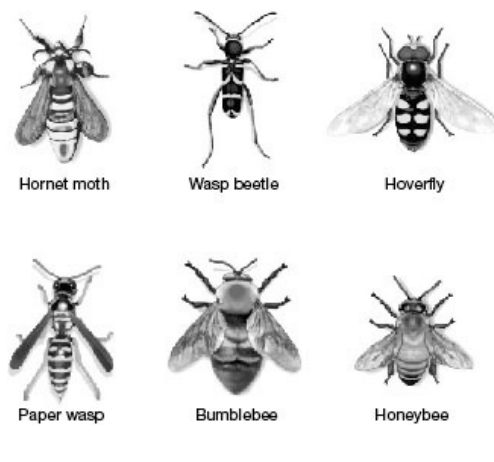
In the accompanying figure, which individuals are displaying Batesian mimicry?
A) the paper wasp, bumblebee, and honeybee
B) the hornet moth, wasp beetle, and hoverfly
C) All of the insects are displaying Batesian mimicry.
D) None of the insects is displaying Batesian mimicry.
B) the hornet moth, wasp beetle, and hoverfly

In the accompanying figure, which of the following statements is TRUE?
A) All of the species of insects shown are in the order Hymenoptera.
B) There are no true mimics in the insects shown.
C) All of the insects are displaying Batesian mimicry.
D) Half of the six insects shown are harmless.
D) Half of the six insects shown are harmless.
While traveling in Texas, you stumble across a snake with red, yellow, and black bands. You somehow remember that this could be a poisonous coral snake or a harmless milk snake, but you forget how to differentiate them because they both have similar colors and banding patterns. You wisely decide not to pick up the snake. What defense of the snake was successful in preventing you from grabbing the snake?
A) constitutive defense
B) Müllerian mimicry
C) Batesian mimicry
D) inducible defense
C) Batesian mimicry
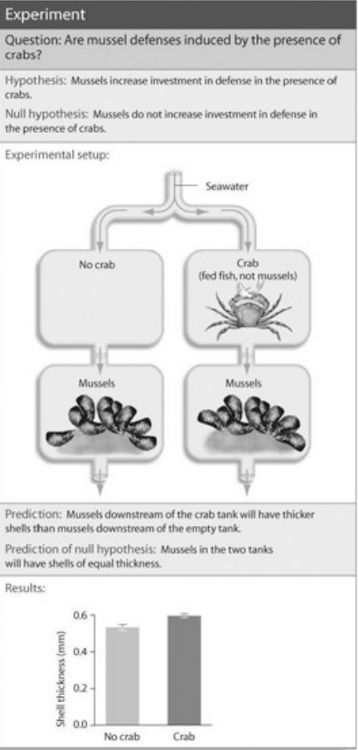
What conclusion can you draw from the accompanying figure?
A) Without direct contact, mussels can sense the presence of crabs.
B) Mussels can sense the presence of crabs only visually.
C) Mussels are increasing their shell thickness in response to water current.
D) Shell thickness is a non-inducible defense.
E) Crabs hunt for mussels by focusing on the chemicals they emit into the water.
A) Without direct contact, mussels can sense the presence of crabs.
Which species interaction depends on prey density and effectiveness of prey defenses to determine the impact on the prey population?
A) competition
B) consumption
C) mutualism
D) commensalism
B) consumption
In biology, an arms race occurs when ________.
A) predators become dominant over their prey species leading to the local extinction of the prey
B) a new species evolves into two separate species
C) a new niche is created because of interactions between species
D) there is a repeating cycle of coevolution
E) a prey species adapts and is able to coexist with its predators
D) there is a repeating cycle of coevolution
People with at least one copy of the HLA-B53 gene are better able to beat back malarial infections before the infection progresses. If this is a coevolutionary arms race between Plasmodium and humans, what would the next step in this race be?
A) to see humans with more than one copy of the HLA-B53 gene
B) to see humans without the HLA-B53 gene
C) to see Plasmodium populations that counter the HLA-B53 gene
D) to see Plasmodium populations that have the HLA-B53 gene
E) to see a mutation in the HLA-B53 gene that makes it more effective against malarial infections
C) to see Plasmodium populations that counter the HLA-B53 gene
Which statement best describes the evolutionary significance of mutualism?
A) Mutualism offers more biodiversity to a community.
B) Individuals partaking in a mutualistic relationship are more resistant to parasites.
C) Interaction increases the survival and/or population growth rate(s) of mutualistic species.
D) Mutualistic interaction lessens competition in communities where it is present.
E) Mutualistic relationships allow organisms to synthesize and use energy more efficiently
C) Interaction increases the survival and/or population growth rate(s) of mutualistic species.
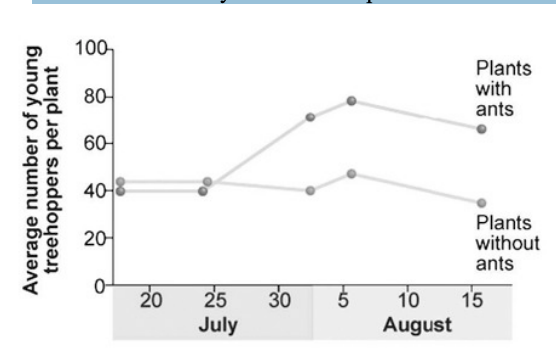
Treehoppers (a type of insect) produce honeydew, which ants use for food. Treehoppers have a major predator, the jumping spider. Researchers hypothesized that the ants would protect the treehoppers from the spiders. In an experiment, researchers followed study plots with ants removed from the system and compared them to a control plot. In the figure shown, what can you conclude?
A) Ants do somehow protect the treehoppers from spiders.
B) Ants eat the honeydew produced by treehoppers.
C) Ants reduce the numbers of treehoppers.
D) No specific conclusions can be drawn from this figure.
E) Treehoppers do not produce honeydew in July and are not protected by the ants
A) Ants do somehow protect the treehoppers from spiders.

During a one-year study, researchers found no difference in treehopper populations in any of their control and experimental groups. What could they measure during the second year to gain information about why this might have occurred?
A) Measure the number of ant females.
B) Measure the relative sizes of the treehoppers.
C) Measure the relative abundance of jumping spiders.
D) Measure the relative sizes of different ant species
C) Measure the relative abundance of jumping spiders.
What interactions exist between a lion pride and a hyena pack?
A) +/+ B) +/0 C) +/− D) 0/0 E) −/−
E) −/−
What interactions exist between a tick on a dog and the dog?
A) +/+
B) +/0
C) +/−
D) 0/0
E) −/−
C) +/−
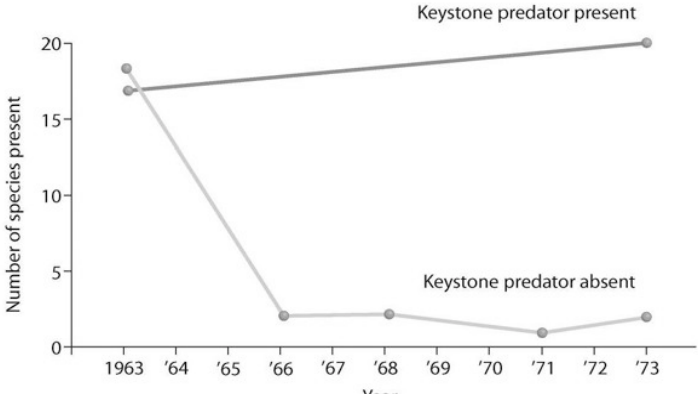
What does the graph in the accompanying figure tell you about the definition of a keystone species?
A) A keystone species has little interaction with other species in an environment.
B) Removing a keystone species from the community drastically reduces diversity.
C) Adding a keystone species to the community will make it more diverse.
D) Removing a keystone species from the community will eventually allow for the invasion of a new species.
B) Removing a keystone species from the community drastically reduces diversity.
Recall that Clements's view of biological communities is that of a highly predictable and interrelated structure, while Gleason's view of biological communities is that individual species operate independently. If we set up many identical sterilized ponds in the same area and allowed them to be colonized, what should we predict if we wished to test Gleason's hypothesis?
A) Identical plankton communities will develop in all ponds.
B) Similar plankton communities will develop in all ponds.
C) Different plankton communities will develop in all ponds.
D) Limited plankton communities will develop in all ponds.
E) Initially the number of species in each pond will be greater than the number normally found in similar environments.
C) Different plankton communities will develop in all ponds.
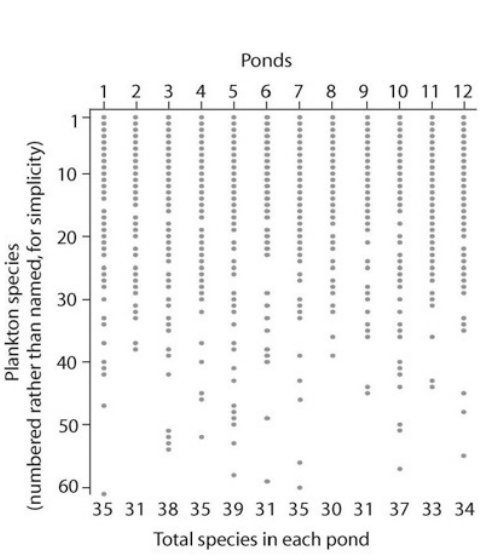
Looking at the results in the accompanying figure, which hypothesis (by Clements or Gleason) is supported by the data?
I. Clements
II. Gleason
A) only I
B) only II
C) both I and II
D) neither I nor II
C) both I and II
Which one of the following animals would most likely be defined as a keystone species?
A) sea otter
B) housefly
C) fathead minnow
D) nauplii (a species of zooplankton
A) sea otter
Which of the following would be most significant in understanding the structure of an ecological community?
I. determining how many species are present overall
II. determining which particular species are present
III. determining the kinds of interactions that occur among organisms of different species
IV. determining the relative abundance of species
A) only I and III
B) only II and IV
C) only I, II, and III
D) only II, III, and IV
E) I, II, III, and IV
E) I, II, III, and IV
In a tide pool, 15 species of invertebrates were reduced to 8 after one species was removed. The species removed was likely a(n) ________.
A) pathogen
B) keystone species
C) herbivore
D) resource partitioner
E) mutualistic organism
B) keystone species
Elephants are not the most dominant species in African grasslands, yet they influence community structure. The grasslands contain scattered woody plants, but they are kept in check by the uprooting activities of the elephants. Take away the elephants, and the grasslands convert to forests or to shrublands. The newly growing forests support fewer species than the previous grasslands. Which of the following describes why elephants are the keystone species in this scenario?
A) Elephants exhibit a disproportionate influence on the structure of the community relative to their abundance.
B) Grazing animals depend upon the elephants to convert forests to grassland.
C) Elephants prevent drought in African grasslands.
D) Elephants are the biggest herbivore in this community.
E) Elephants help other populations survive by keeping out many of the large African predators.
A) Elephants exhibit a disproportionate influence on the structure of the community relative to their abundance.
) According to bottom-up and top-down control models of community organization, which of the following expressions would imply that an increase in the size of a carnivore (C) population would negatively impact its prey (P) population, but not vice versa?
A) P ← C
B) P → C
C) C ↔ P
D) P ← C → P
A) P ← C
What is the main difference between a disturbance and a disturbance regime?
A) A disturbance regime includes defining the predictable frequency and severity of the disturbance.
B) A disturbance regime includes defining the length of the disturbance.
C) A disturbance regime is a more specific type of disturbance.
D) They are essentially the same thing.
A) A disturbance regime includes defining the predictable frequency and severity of the disturbance.
6) What is the main advantage of controlled burnings of forested areas? Controlled burnings ________.
A) eliminate the possibility of forest fires
B) clear forested areas for farmland
C) prevent the overgrowth of the underbrush
D) allow new species to form
C) prevent the overgrowth of the underbrush
Which of the following terms do ecologists use to describe the community interaction where one organism makes the environment more suitable for another organism?
A) parasitism
B) mutualism
C) inhibition
D) facilitation
E) commensalism
D) facilitation
Why do moderate levels of disturbance result in an increase in community diversity?
A) Habitats are opened up for less competitive species.
B) Competitively dominant species infrequently exclude less competitive species after a moderate disturbance.
C) The environmental conditions become optimal.
D) The resulting uniform habitat supports stability, which in turn supports diversity.
A) Habitats are opened up for less competitive species.
In a particular case of secondary succession, three species of wild grass all invaded a field. By the second season, a single species dominated the field. A possible factor in this secondary succession was ________.
A) equilibrium
B) facilitation
C) immigration
D) inhibition
E) parasitism
D) inhibition
Which of the following are responsible for generating successional pathways?
I. species interactions
II. historical and environmental context
III.species traits
A) I only
B) II only
C) III only
D) II and III only
E) I, II, and III
E) I, II, and III
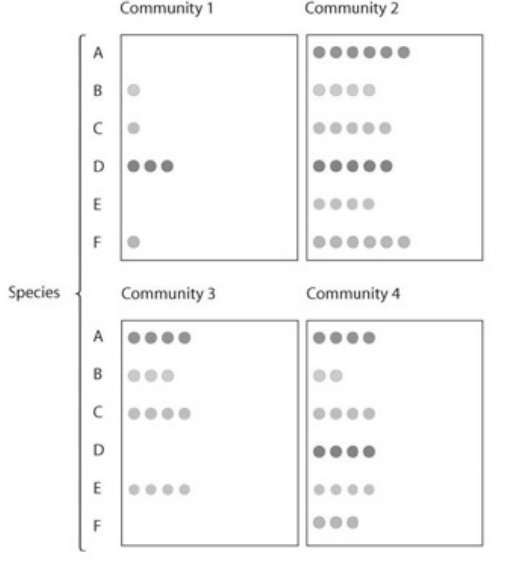
In the accompanying figure, where do we find the highest species richness?
A) Community 1
B) Community 2
C) Community 3
D) Community 4
E) Communities 2 and 4
E) Communities 2 and 4

In the figure shown, which community has the highest species diversity?
A) Community 1
B) Community 2
C) Community 1 and Community 3 have the highest species diversity.
D) Community 4
B) Community 2
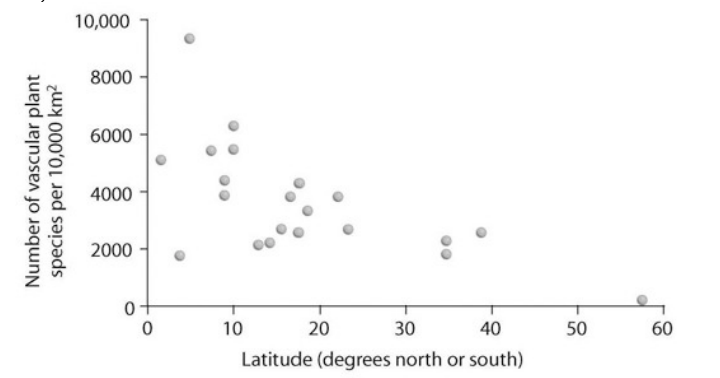
In the accompanying figure, what can be stated about species diversity and latitude?
A) As latitude increases, diversity decreases. B) As latitude decreases, diversity decreases. C) Species diversity is independent of latitude. D) Species diversity and latitude cannot be compared using this figure.
A) As latitude increases, diversity decreases.
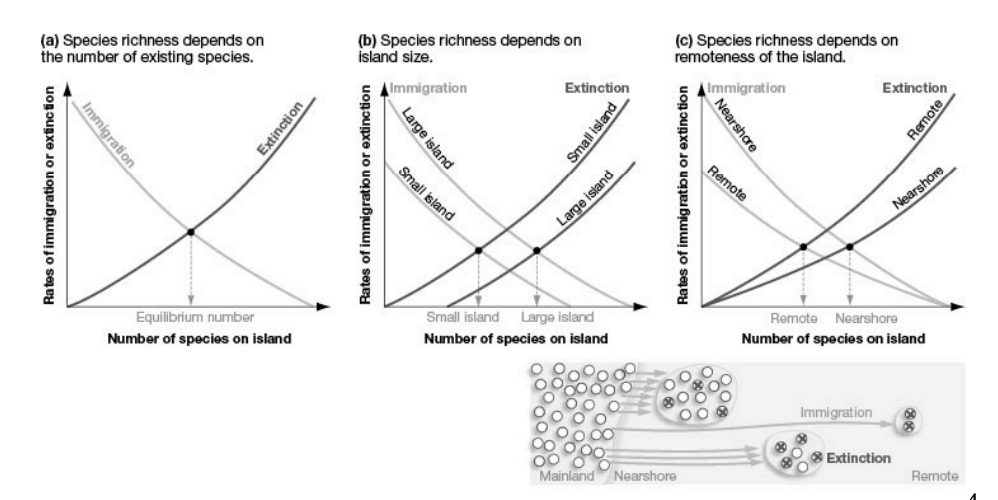
Which of the following statements regarding the figure shown is TRUE?
A) Immigration rates are higher on smaller islands.
B) Extinction rates are highest on large islands close to the mainland.
C) Species richness should be higher on larger islands close to the mainland.
D) Species diversity should be highest on larger islands away from the mainland.
C) Species richness should be higher on larger islands close to the mainland.

According to the figure shown, a species has the highest chance of extinction when ________. A) the island is large and close to the mainland B) the island is small and close to the mainland C) the island is large and remote
D) the island is small and remote
D) the island is small and remote
Species richness increases ________.
A) as we increase in altitude in equatorial mountains
B) as we travel southward from the North Pole
C) on islands as distance from the mainland increases
D) as depth increases in aquatic communities
E) as community size decreases
B) as we travel southward from the North Pole
There are more species in tropical areas than in places more distant from the equator. This is probably a result of ________.
A) fewer predators
B) more intense annual solar radiation
C) more frequent ecological disturbances
D) fewer agents of disease
B) more intense annual solar radiation
Which of the following is a widely supported explanation for the tendency of tropical communities to have greater species diversity than temperate or polar communities?
A) They are less likely to be affected by human disturbance.
B) There are fewer parasites to negatively affect the health of tropical communities.
C) Tropical communities are low in altitude, whereas temperate and polar communities are high in altitude.
D) Tropical communities are generally older than temperate and polar communities.
E) More competitive dominant species have evolved in temperate and polar communities.
D) Tropical communities are generally older than temperate and polar communities.
Which of the following is a correct statement about the MacArthur/Wilson Island Biogeography Model?
A) The more species that inhabit an island, the lower the extinction rate.
B) As the number of species on an island increases, the emigration rate decreases.
C) Competitive exclusion is less likely on an island that has large numbers of species.
D) Small islands receive few new immigrant species.
E) Islands closer to the mainland have higher extinction
D) Small islands receive few new immigrant species.
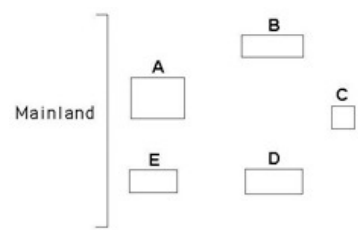
52) Which island would likely have the greatest species diversity?
A) A B) B C) C D) D E) E
A) A

Which island would likely exhibit the most impoverished species diversity?
A) A B) B C) C D) D E) E
C) C

Which island would likely have the lowest extinction rate?
A) A B) B C) C D) D E) E
A) A